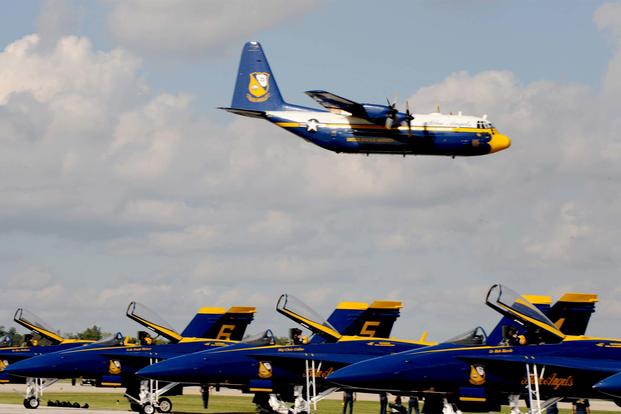The Marine Corps is grounding its fleet of KC-130T transport aircraft, and the Blue Angels is giving its C-130 "Fat Albert" some time off as investigators continue to probe the cause of a KC-130T crash that left 16 troops dead July 10.
Two separate investigations are ongoing in the wake of the crash: an aviation mishap investigation and a Marine Corps Command investigation, Marine Forces Reserve spokesman Capt. Andrew Chrestman told Military.com.
In light of that investigation, the Blue Angels canceled the appearance of Fat Albert, a C-130T with a Marine Corps crew, at the EAA AirVenture Oshkosh air show in Oshkosh, Wisconsin. That show began July 24 and continues through July 30.
"During the course of the ongoing Marine Corps KC-130T investigation, an airframe similar to Fat Albert, we determined it may be prudent to allow time for the investigation to provide more information on possible causal factors prior to resuming flight," Lt. Joe Hontz, a Blue Angels spokesman, told Military.com in a statement.
He did not immediately respond to questions about whether the aircraft would miss more shows.
The Corps has also grounded its fleet of KC-130T aircraft, Marine Forces Reserve spokeswoman 2nd Lt. Stephanie L. Leguizamon told Military.com.
"Out of an abundance of caution, the Marine Corps took the prudent action to not fly our KC-130T aircraft in the wake of the mishap until further notice," she said.
The KC-130T is the oldest variant of the aircraft still flying, with an average age of roughly 24.9 years. Only one unit still flies them: Marine Aerial Refueler Transport Squadron [VMGR]-452, the reserve squadron that owned the aircraft that went down in the crash.
There are 12 KC-130T aircraft remaining in the Corps' inventory, Leguizamon said.
A Marine Corps spokeswoman, Capt. Sarah Burns, said no other Marine C-130 aircraft are affected by the grounding.
In a press conference following the tragedy, Brig. Gen. Bradley James, commanding general of 4th Marine Aircraft Wing, said early evidence indicated something went wrong while the aircraft was at cruise altitude.
This may be a strong indicator of mechanical failure rather than human error as a cause of the crash, sources familiar with the C-130 told Military.com. It will likely be weeks or months before the military investigations into the crash are complete, however.
Killed in the crash were nine air crew from VMGR-452, and six Marines and a sailor from Marine Corps Forces Special Operations Command, who had been traveling from North Carolina to Yuma, Arizona, for early training ahead of a deployment to the Middle East.
-- Hope Hodge Seck can be reached at hope.seck@military.com. Follow her on Twitter at @HopeSeck.





























